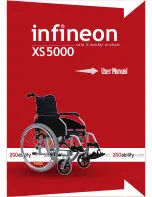
19
ENGLISH
Inspection and Adjustment
WARNING
Traveling without anti-tippers or with the anti-tip bars shorter than the
“standard length” may cause a rollover. Never use the wheelchair
without making the correct adjustments.
(1) Push the pin and slide the anti-tip bar when adjusting the anti-tipper. Be
sure to secure the bar until the pin comes out with a “click” sound.
(2) Then check that there is 5 to 10 cm of space between the casters and the
ground surface, with the small wheel at the end of the anti-tipper touching the
ground. If the space is too small or too large, adjust the bar to one of the other
holes in the front or rear.
1. Anti-Tipper
2. Tire Air Pressure
3. Inspection of the Wheelchair Body and Wheels
The effectiveness of the wheel locks and the general driving ease are
dependent on adequate air pressure. Correctly inflated rear wheels and equal
air pressure on both wheels considerably improve maneuverability of your
wheelchair.
WARNING
Therefore, before starting your wheelchair, check the pneumatic tires for
proper inflation levels (printed on the side wall of the tire). The correct air
pressure for the rear wheels should be at least 3.5 bar (350 kPa). Efficiency
of the brakes can be ensured only if sufficient air pressure and correct
adjustment (5 mm distance at the maximum, subject to technical alterations)
have been provided.
Be sure the pneumatic tires have sufficient tread depth.
WARNING
Continuing to use the wheelchair with a problem in the wheelchair body or
the wheels may cause sudden damage to the wheelchair while traveling,
and may result in a rollover or the wheelchair being upset.
Always check the condition of each part of the wheelchair. If you detect any
problems, have the wheelchair inspected and repaired by the dealer.
· Crack in the frame
· Loosening of components
· Loosening or breakage of the spokes
· Effectiveness of the brakes
· Deformation of the casters
· Wear of the tires















































